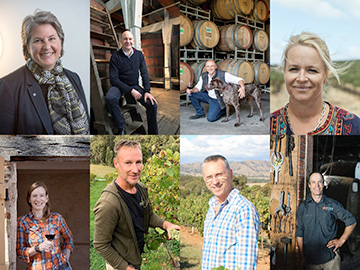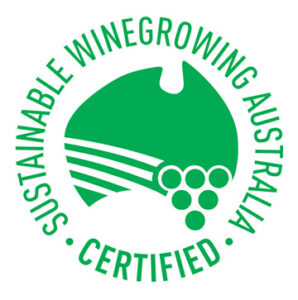Vote now in the AWRI Board election!
Gingin Chardonnay mystery solved
New Business Development Manager
Sustainable Winegrowing Australia update
Flotation: from mining to water to the wine industry
Order the latest AWRI staff publications online
Vote now in the AWRI Board election! |
|
 |
Voting is closing soon in the AWRI Board elections, with the poll closing at 5:00 pm CST on Friday, 11 September. In this year’s election, candidates are standing in the small, medium and large levy payer categories, which means all wine grapes levy payers are eligible to vote for their preferred candidate. The voting process in online and easy to complete. Voting instructions, candidate profiles and further information are available from the AWRI website or by contacting Shiralee Dodd, the Returning Officer, at returningofficer@awri.com.au. Voting in the AWRI Board election is an excellent opportunity to contribute to the Australian grape and wine research and development agenda and ensure the AWRI is in safe hands. |
Gingin Chardonnay mystery solvedThe AWRI recently published a paper that puts to rest the mystery of the Gingin Chardonnay clone. For many years, the origin of this popular Western Australian Chardonnay clone has been hotly debated. Gingin was believed by some to be derived from the same source material as a clone known as Old Foundation Block (OF) Chardonnay, but was also commonly thought of as being the same as another clone with similar traits called Mendoza. Results from the new genomics research have revealed that all three clones have a shared heritage, in an old Californian source block at UC Davis. They are, however, quite distinct from each other. In particular, Gingin and Mendoza are as different from each other as they are from any of the other clonal selections of Chardonnay, despite their shared origins. This work has not only solved a decades-old mystery – it represents a significant leap forward for grapevine genomics and demonstrates that a great deal more is possible beyond simply confirming grape variety. The panel of clonal markers identified for Chardonnay will be useful for verification of planting material by nurseries and vineyard owners and for targeted importation of clones not currently available in Australia. The work also forms a foundation for identifying clonal markers in other grape varieties and potentially other crops. The full paper detailing these results is accessible from the AWRI library: Roach, M.J., Borneman, A.R., Schmidt, S.A. 2020. Origin of Chardonnay clones with historical significance in Australia and California. Aust. J. Grape Wine Res. doi: 10.1111/ajgw.12448. |
|
New Business Development Manager |
|
 |
Last month the AWRI welcomed Dr Tony Robinson into the role of Business Development Manager. Tony is well known to many in our industry from his longstanding involvement with the ASVO (including as ASVO President) and with the AWITC. Tony brings to the AWRI a wealth of commercial experience across viticulture, winemaking and wine business operations. Prior to accepting this role, he was working as Chief Operating Officer for Y-Group in WA, and before that he held the role of Grape and Wine Innovation Specialist at Treasury Wine Estates. Tony holds a PhD in Oenology from Murdoch University and a Bachelor of Science with First Class Honours in Horticulture and Viticulture from the Universities of Western Australia and Adelaide. More information about Tony can be found in this media release. |
Sustainable Winegrowing Australia – update on trust mark and research projects |
|
 |
The Australian grape and wine industry’s sustainability program, Sustainable Winegrowing Australia is growing strongly, with more than 100 new members having joined the program since 1 July 2020. Queries about the program are also increasing, including from other sectors interested in learning from the grape and wine industry’s experience and expertise.
The AWRI recently partnered with NAB and the Queensland University of Technology on a Food Agility Cooperative Research Centre project investigating ways of linking sustainability metrics to financial performance. An article from NAB about the economic importance of natural assets, which includes some findings from that project, is available online here. Members who have not yet submitted their membership data and workbook for 2019-20 are asked to log in to the Sustainable Winegrowing Australia website and complete their data entry as soon as possible. Data from all members is required to enable the review of the regional and national datasets and preparation of benchmarking reports. Support for members is available from the AWRI helpdesk on 08 8313 6600 or helpdesk@awri.com.au. |
Flotation: from mining to water to the wine industryFlotation is a technique that has resulted in important efficiency improvements, not just in wineries, but also in minerals processing and wastewater treatment. Flotation was used in minerals processing first, but wine industry flotation techniques have much more in common with techniques used for wastewater clarification, and it is from that sector where flotation crossed to the wine sector and took hold. Water and wine industry flotation are primarily about clarification, with the valuable product being the clarified juice or water underneath the floating solids, while in the mining sector, the valuable minerals are often collected in the floats. AWRI Senior Engineer Simon Nordestgaard recently published an article in Aust. N.Z. Grapegrower & Winemaker that includes information on the history and adoption of flotation, which can be viewed here. |
|
Upcoming events and webinarsWith travel restrictions still in place across much of Australia, the AWRI events team is continuing to present a range of virtual events, including tastings. Chardonnay winemaking trial workshops have been successfully held via video conference in Stanthorpe and Mudgee in recent weeks and will continue across NSW/ACT in September. At the same time, seven new webinars have been scheduled, taking the program through until January 2021. Upcoming webinar topics include the impact of COVID-19 and other geopolitical factors on Australia’s wine exports, water addition to must and drivers of regional character in Pinot Noir. For all the details of upcoming events and webinars, visit the AWRI events calendar. |
|
Order the latest AWRI staff publications onlineAccessing the latest AWRI publications is easy. Visit the AWRI Publications web page to:
The AWRI’s most recent publications are listed below. 2162 Day, M., Bindon, K., Capone, D., Kassara, S., Bilogrevic, E., Espinase Nandorfy, D., Watson, F., Francis, L., Krstic, M. Going green with whole bunches. Wine Vitic. J. 35(2): 29-30; 2020. 2163 Dry, P. Carignan. Wine Vitic. J. 35(2): p. 50; 2020. 2164 Godden, P. Ask the AWRI: Pre-fermentation skin contact. Aust. N.Z. Grapegrower Winemaker (676): 52-53; 2020. 2165 Nordestgaard, S. Inspirations from the past and opportunities for the future. Part 1: Cross-flow filtration and flotation. Aust. N.Z. Grapegrower Winemaker (676): 58-63; 2020. 2166 Visalakshan, R.M., González García, L.E., Benzigar, M.R., Ghazaryan, A., Simon, J., Mierczynska-Vasilev, A., Michl, T.D., Vinu, A., Mailänder, V., Morsbach, S., Landfester, K., Vasilev, K. The influence of nanoparticle shape on protein corona formation. Small 2000285; 2020. 2167 Longbottom, M. Ask the AWRI: Understanding the factors that influence grapevine yield. Aust. N.Z. Grapegrower Winemaker (677): 34-35; 2020. 2168 Nordestgaard, S. Inspirations from the past and opportunities for the future. Part 2: In-tank fermentation monitoring and continuous processes. Aust. N.Z. Grapegrower Winemaker (677): 50-56; 2020. 2169 Pereira-Caro, G., Gaillet, S., Mena, P., Bresciani, L., Bindon, K.A., Del Rio, D., Rouanet, J-M., Moreno-Rojas, J.M., Crozier, A. Bioavailability of red wine and grape seed proanthocyanidins in rats. Food Funct. 11: 3986-4001; 2020. 2170 Hixson, J., Bilogrevic, E., Capone, D., Nandorfy, D.E., Francis, L., Petrie, P., Solomon, M., Krstic, M. Enhancing tropical fruit flavour in Chardonnay and Shiraz through foliar nutrient sprays. Wine Vitic. J. 35(3): 30-33; 2020. 2171 Cuijvers, K., Van Den Heuvel, S., Varela, C., Rullo, M., Solomon, M., Schmidt, S., Borneman, A. Alterations in yeast species composition of uninoculated wine ferments by the addition of sulphur dioxide. Fermentation 6(2): 62; 2020. 2172 Cowey, G. Ask the AWRI: Amber wine. Aust. N.Z. Grapegrower Winemaker (678): 49-50; 2020. 2173 Nordestgaard, S. Inspirations from the past and opportunities for the future. Part 3: Volume measurement, product movements and gas adjustment. Aust. N.Z. Grapegrower Winemaker (678): 66-68, 70-71; 2020. 2174 Roach, M.J., Borneman, A.R., Schmidt, S.A. Origin of Chardonnay clones with historical significance in Australia and California. Aust. J. Grape Wine Res. doi:10.1111/ajgw.12448: 1-5; 2020. 2175 Wu, Q., Habili, N., Constable, F., Al Rwahnih, M., Goszczynski, D.E., Wang, Y., Pagay, V. Virus pathogens in Australian vineyards with an emphasis on Shiraz disease. Viruses 12: 818; 2020. 2176 Coulter, A. Ask the AWRI: DMDC – an insurance policy. Aust. N.Z. Grapegrower Winemaker (679): 52-53; 2020. 2177 Moate, P.J., Jacobs, J.L., Hixson, J.L., Deighton, M.H., Hannah, M.C., Morris, G.L., Ribaux, B.E., Wales, W.J., Williams, S.R.O. Effects of feeding either red or white grape marc on milk production and methane emissions from early-lactation dairy cows. Animals 10(6): 976; 2020. 2178 Szeto, C., Ristic, R., Capone, D., Puglisi, C., Pagay, V., Culbert, J., Jiang, W-W., Herderich, M., Tuke, J., Wilkinson, K. Uptake and glycosylation of smoke-derived volatile phenols by Cabernet Sauvignon grapes and their subsequent fate during winemaking. Molecules 25(16): 3720; 2020. 2179 Longo, R., Pearson, W., Merry, A., Solomon, M., Nicolotti, L., Westmore, H., Dambergs, R., Kerslake, F. Preliminary study of Australian Pinot noir wines by colour and volatile analyses, and the Pivot© Profile method using wine professionals. Foods 9(9): 1142; 2020. 2180 Dry, P. Arinto de Bucelas. Wine Vitic. J. 35(3): 59; 2020. 2181 Xing, F., Gao, D., Liu, H., Wang, H., Habili, N., Li, S. Molecular characterization and pathogenicity analysis of prunus necrotic ringspot virus iolates from China rose (Rosa chinensis Jacq.). Arch. Virol. doi:10.1007/s00705-020-04739-8: 2020. 2182 Varela, C., Bartel, C., Onetto, C., Borneman, A. Targeted gene deletion in Brettanomyces bruxellensis with an expression-free CRIPR-Cas9 system. Appl. Microbiol. Biotechnol. 104: 7105-7115: 2020. 2183 Teng, B., Petrie, P.R., Nandorfy, D.E., Smith, P., Bindon, K. Pre-fermentation water addition to high-sugar Shiraz must: effects on wine composition and sensory properties. Foods 9(9): 1193; 2020. |
|
AcknowledgementsThe AWRI acknowledges support from Australia’s grapegrowers and winemakers through their investment body, Wine Australia, with matching funds from the Australian Government. The AWRI is a member of the Wine Innovation Cluster in Adelaide, South Australia. |
|

